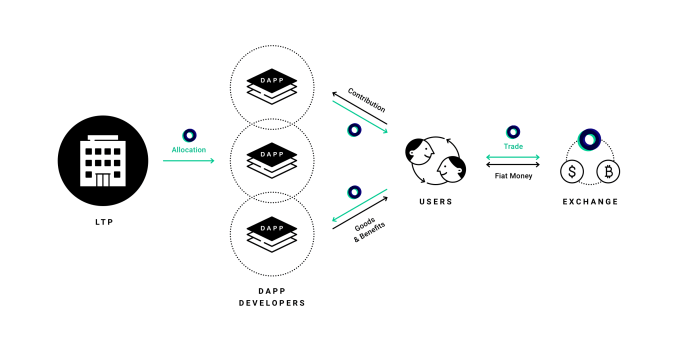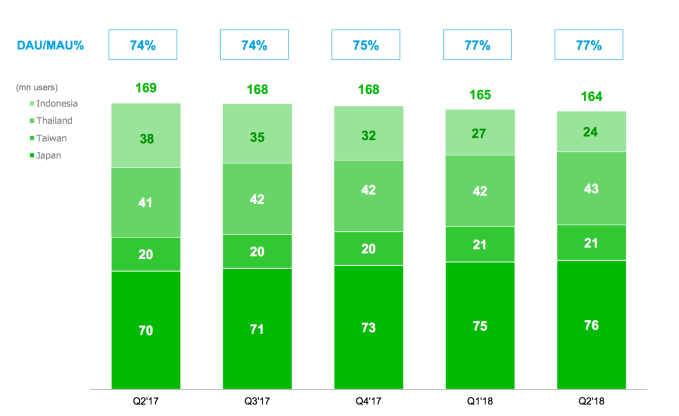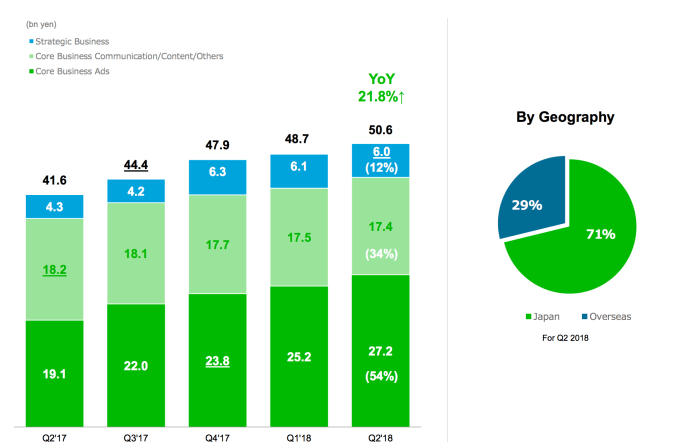
By JULIE HIRSCHFELD DAVIS from NYT U.S. https://ift.tt/2MGXVdB




Line, the Japanese messaging app firm that’s best known for its cutesy characters and stickers, is pushing deeper into crypto after it launched its own token to help grow its stagnant user base.
Line went public two years ago with 218 million monthly active users, but it hasn’t been able to kick on. The company no longer gives out its worldwide user number, but the number of active users in its four biggest markets has fallen from 169 million in Q2 2017 to 164 million in its recent Q2 2018 period.
Link — Line’s token — isn’t being minted through an ICO, instead, it’ll be given out to Line users as an incentive for using certain services. Line hasn’t said exactly how it can be earned yet, although it is likely that it’ll be tied to specific activities to promote engagement.

Line plans to use Link to incentive user activity on its messaging app and other services
The token will be listed on Bitbox — Line’s crypto exchange — and it’ll be used it to buy content like stickers and webcomics, as well as other Line services. It’ll also be possible to use Link to get a lower commission rate on trading in the same way that Binance, the world’s largest exchange, uses its BNB token.
Line currently has a virtual currency for its in-app content and services, and you’d imagine that Link will replace it in the future.
It’s worth noting, however, that Link hasn’t launched in Japan yet. That’s because Line is awaiting regulatory approval for its token and exchange, so, for now, those in Japan — which is Line’s largest market — will earn virtual tokens which can be traded for Link in the future.

Line is struggling to grow its user numbers
Link will launch next month, and it follows the announcement of BitBox in July and the launch of a dedicated crypto fund in early August.
Line has dodged the legal questions around token sales by not holding an ICO, and the fact it is using the currency to incentivize user engagement and activity isn’t a huge surprise. Line went public in a dual U.S-Japan IPO that raised over $1 billion in 2016 but, despite user numbers declining, it has grown its revenue through additional services.
Increased competition from the likes of Facebook Messenger and WhatsApp is likely its biggest threat, so incentivizing users is a logical strategy. Of course, that depends on how useful Link becomes. If users can exchange it for a decent amount of cash or credits inside Line’s platform it may gain appeal, but if they just pick up trivial amounts, it may be less interesting to them. The bigger picture will be when Link replaces Line’s virtual currency for all purchases but that alone isn’t likely to boost user engagement.

Despite declining user numbers, Line has grown revenue by pushing out services that connect to its messaging platform.
Line also plans to use Link — and the blockchain it has developed to power it — to host decentralized applications (dapps) that will connect to its messaging platform. The company already does a lot more than messaging — for example payments, ride-hailing, music and videos — and it plans to tap third-party developers to build dapps. Generally, though, dapps haven’t taken off. The collectibles game Cryptokitties did blow up late last year, but studies have suggested user activity is massively down this year as the fad has slowly worn off.
Crypto enthusiasts will no doubt take positives from Line’s latest move — it is arguably the largest company to embrace crypto, in terms of end-user audience reach — but it remains to be seen whether Link and its dapps platform can help it crack its user growth and retention issues.
“Over the last seven years, Line was able to grow into a global service because of our users, and now with Link, we wanted to build a user-friendly reward system that gives back to our users. With Link, we would like to continue developing as a user participation-based platform, one that rewards and shares added value through the introduction of easy-to-use dapps for people’s daily lives,” said Line CEO Takeshi Idezawa in a statement.
Unlike Bitcoin, which is mined, Line has minted a total of one billion Link tokens which it said will be “gradually issued according to how this ecosystem develops.” The company plans to keep 200 million tokens, with the remaining 800 million made available as user rewards.
Note: The author owns a small amount of cryptocurrency. Enough to gain an understanding, not enough to change a life.

































Research scientists at Queen’s University’s Human Media Lab have built a prototype touchscreen device that’s neither smartphone nor tablet but kind of both — and more besides. The device, which they’ve christened the MagicScroll, is inspired by ancient (papyrus/paper/parchment) scrolls so it takes a rolled-up, cylindrical form factor — enabled by a flexible 7.5inch touchscreen housed in the casing.
This novel form factor, which they made using 3D printing, means the device can be used like an erstwhile rolodex (remember those?!) for flipping through on-screen contacts quickly by turning a physical rotary wheel built into the edge of the device. (They’ve actually added one on each end.)
Then, when more information or a deeper dive is required, the user is able to pop the screen out of the casing to expand the visible display real estate. The flexible screen on the prototype has a resolution of 2K. So more mid-tier mobile phone of yore than crisp iPhone Retina display at this nascent stage.
[gallery ids="1702214,1702215,1702211,1702212,1702213"]
The scientists also reckon the scroll form factor offers a pleasing ergonomically option for making actual phone calls too, given that a rolled up scroll can sit snugly against the face.
Though they admit their prototype is still rather large at this stage — albeit, that just adds to the delightfully retro feel of the thing, making it come over like a massive mobile phone of the 1980s. Like the classic Motorola 8000X Dynatac of 1984.
While still bulky at this R&D stage, the team argues the cylindrical, flexible screen form factor of their prototype offers advantages by being lightweight and easier to hold with one hand than a traditional tablet device, such as an iPad. And when rolled up they point out it can also fit in a pocket. (Albeit, a large one.)
They also imagine it being used as a dictation device or pointing device, as well as a voice phone. And the prototype includes a camera — which allows the device to be controlled using gestures, similar to Nintendo’s ‘Wiimote’ gesture system.
In another fun twist they’ve added robotic actuators to the rotary wheels so the scroll can physically move or spin in place in various scenarios, such as when it receives a notification. Clocky eat your heart out.
“We were inspired by the design of ancient scrolls because their form allows for a more natural, uninterrupted experience of long visual timelines,” said Roel Vertegaal, professor of human-computer interaction and director of the lab, in a statement.
“Another source of inspiration was the old rolodex filing systems that were used to store and browse contact cards. The MagicScroll’s scroll wheel allows for infinite scroll action for quick browsing through long lists. Unfolding the scroll is a tangible experience that gives a full screen view of the selected item. Picture browsing through your Instagram timeline, messages or LinkedIn contacts this way!”
“Eventually, our hope is to design the device so that it can even roll into something as small as a pen that you could carry in your shirt pocket,” he added. “More broadly, the MagicScroll project is also allowing us to further examine notions that ‘screens don’t have to be flat’ and ‘anything can become a screen’. Whether it’s a reusable cup made of an interactive screen on which you can select your order before arriving at a coffee-filling kiosk, or a display on your clothes, we’re exploring how objects can become the apps.”
The team has made a video showing the prototype in action (embedded below), and will be presenting the project at the MobileHCI conference on Human-Computer Interaction in Barcelona next month.
While any kind of mobile device resembling the MagicScroll is clearly very, very far off even a sniff of commercialization (especially as these sorts of concept devices have long been teased by mobile device firms’ R&D labs — while the companies keep pumping out identikit rectangles of touch-sensitive glass… ), it’s worth noting that Samsung has been slated to be working a a smartphone with a foldable screen for some years now. And, according to the most recent chatter about this rumor, it might be released next year. Or, well, it still might not.
But whether Samsung’s definition of ‘foldable’ will translate into something as flexibly bendy as the MagicScroll prototype is highly, highly doubtful. A fused clamshell design — where two flat screens could be opened to seamlessly expand them and closed up again to shrink the device footprint for pocketability — seems a much more likely choice for Samsung designers to make, given the obvious commercial challenges of selling a device with a transforming form factor that’s also robust enough to withstand everyday consumer use and abuse.
Add to that, for all the visual fun of these things, it’s not clear that consumers would be inspired to adopt anything so different en masse. Sophisticated (and inevitably) fiddly devices are more likely to appeal to specific niche use cases and user scenarios.
For the mainstream six inches of touch-sensitive (and flat) glass seems to do the trick.








